|

|
Spotlight USA
Tara M. McGowan
Dear Readers,
The past three interviews in this series have demonstrated the variety of kamishibai performances around the globe from Peru to Sweden to Turkey. This issue focuses on the diversity of practice within the USA. It features the work of four kamishibai storyteller/teachers in Texas and New York State.
A common misconception about kamishibai, even in Japan, is that it is a medium only for very young children. This is because in recent years, publishers in Japan have tended to cater to that audience. A look at the history of kamishibai, however, reveals that it is a format, not a genre, and can be adapted to any age group or audience.
As the following interviews illustrate, a key characteristic of kamishibai is that it only comes alive through performance—whether students perform for each other, as in Diana Garcia's bilingual 4th grade class in Texas; perform their own stories in hand-made cereal box stages, as in Beth Davis and Audra Rys's unit for high school students in Berne, New York; or join in participatory performance for all ages with storyteller, Nadine Grisar of Brooklyn, New York. The force of kamishibai performance to motivate students, which is the focus of my dissertation (soon to be available in electronic format), comes through in the words of Diana Garcia's students. As Sareya says, “the special thing about the kamishibai is that you could read it to your friends or family, and it shows a spectacular movie.”
Kamishibai is a versatile format with potential for all manner of adaptations, variations, and innovations. In this newsletter, we welcome readers from around the country and across the globe to share the ways they have found kamishibai useful in their own particular context. As these four ladies have shown us, there is much we can learn from each other, and we look forward to hearing from you!
Tara McGowan, PhD
University of Pennsylvania, Graduate School of Education
Author of The Kamishibai Classroom: Engaging Multiple Literacies through the Art of “Paper Theater” (2010)
Diana Garcia—4th Grade
De Zavala Elementary—San Marcos, Texas
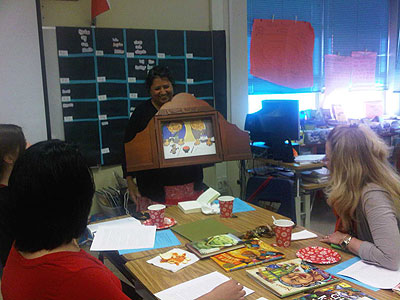
Diana Garcia is a bilingual education teacher, who describes herself like this: “I especially love teaching writing and social studies to my 4th graders. I am an active member of the Austin Social Justice Teachers' Inquiry Group, a network of teacher, grad students and professors who meet once a month to share our resources, ideas, units and projects that teach language arts and social studies through a social justice lens (see photo above). I love art, punk music (I play bass and drums), arty films (I have a children's film club every day at school-we watch the films during lunch time). I'm addicted to coffee and books. I am a gentle Baha'i LOL! And my teen daughter sure keeps me busy at home!”
How did you first hear about Kamishibai?
Several years ago, my friend Jessica Arnston, who is half Japanese, gave me some brochures on kamishibai and on how to teach haiku. I loved the idea of the kamishibai but didn't pursue getting any kamishibai sets because I just didn't have the money. Then last year, I was doing a unit on Allen Say with my students, reading all of his books, and when I read Kamishibai Man, my 4th graders just loved it. I thought, wouldn't it be awesome if I had a real kamishibai? This school year, when I found out that my school district gave small grants for innovative teaching ideas, I wrote up a grant to get two kamishibai stages and several story card sets. Fortunately, the grant committee liked my idea, and I got the funding to purchase 2 kamishibai stages for my school.
What attracted you to try kamishibai with your students?
As a bilingual education teacher, I get to work with a student population that is mostly 95% Hispanic. I have taught for 17 years, and each year I see that my students are not often exposed to other cultures. Last year, when I did the unit on Allen Say, I also included lunch time viewing of many of Hayao Miyazaki's animated films (Japanese anime), and I went to Austin to buy Japanese treats for my students: ramune sodas, seaweed, rice crackers, Japanese candy, and chopsticks for all. My students were so delighted to experience something new. Unfortunately, here in San Marcos, Texas, we have no Asian markets.
When I realized I could get a kamishibai stage through a grant I went for it, figuring that my students need diverse cultural enrichment. As a Hispanic, I grew up with an oral storytelling tradition, and I love storytelling! How wonderful to now also have a Japanese mode of storytelling. Our planet is so full of fabulous art, literature, music from all corners of the world. It's great if children get to learn as much as possible about these creative gifts.
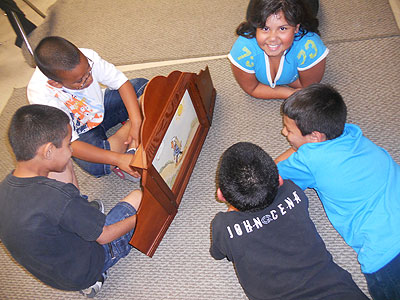
Describe the ways you use kamishibai with your students.
I began by reading a great book called Sylvia and Aki by Winifred Conkling. It tells the true story of a Mexican-American child, Sylvia, who is not permitted to attend a “white” school due to segregation, and Aki, a Japanese child who has to leave her home with her family because of the WWII Japanese-American internment camps. This is a chapter book. After we finished that, I read several of the Allen Say books to the class. After I read the one about the kamishibai man, I asked the students if they would want to see a real kamishibai, which of course they did. The first story I read to my class was The Tongue-cut Sparrow. They loved it! It's still a favorite. Little One Inch comes in second.
I told my students that if they could read a story fluently and with voice, they could go and read to a kindergarten, 1st or 2nd grade class. Right away several students started practicing their reading during Reader's Workshop. I placed a schedule in the teachers' lounge that read, “Who wants a 4th grader to come and read to their class using kamishibai?” Teachers signed up right away and so far I have gotten great feedback from other teachers. A few teachers have requested that my students come back and read again to their students. I plan to keep rotating my students, so they can continue taking the kamishibai stage to the younger students. I offered the other kamishibai stage to any teacher who wanted to try it. A teacher who does tutorials with struggling readers is using the other one now to encourage fluency and reading with expression.
My 4th graders keep using the kamishibai stage in the classroom to practice their fluency and voice during Reader's Workshop.
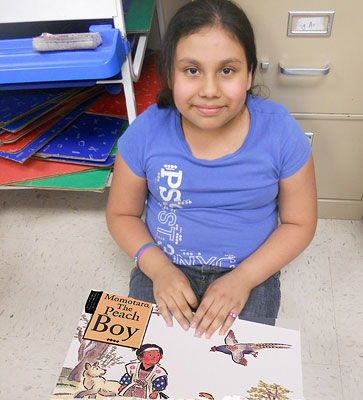
What do you think students are getting out of this particular format? How have they responded?
I have several students whose primary language is Spanish. Five are still lagging behind in learning academic English and reading with more fluency. Four of these students really enjoy using kamishibai. They have all practiced stories repeatedly in order to read with a lot of expression. I was impressed at how these students worked with kamishibai to improve their reading in English. I think kamishibai doesn't feel like a “school book” to them; it's user-friendly. The students get a kick out of the onomatopoeia. I have several English monolinguals who enjoy using kamishibai because they like performing in front of others. These kids especially ask for assignments to read to the younger students.
Kamishibai is a great tool for encouraging students to read aloud, which will help them practice fluency and expression. The stories are repetitive, but not in a boring way, I see my students choosing the same stories over and over. The stories keep them engaged.
We used kamishibai during our Christmas party to each share our wish for the world. Each student decorated a picture card with their vision of world peace, then read what they wrote on the back. Some students wrote that they wished they had enough money to feed hungry children; others wrote that they wished for no more war, no more racism, and to keep our planet clean.
Once our reading camps are over (we have to prepare our students for state-mandated tests), I plan to schedule more “create your own card set activities” for students wishing to pursue that.
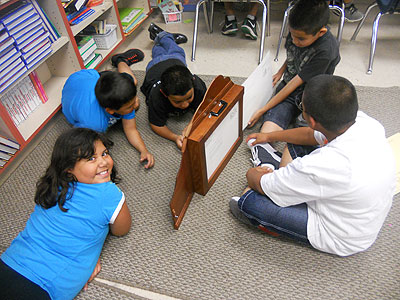
Below are some of the things my students wrote:
“I like that our classroom has a kamishibai because I like the stories. I also like it because we get to go read to different classes. One of my favorite stories is The Tongue-Cut Sparrow. I like going to read to the little kids because it's exciting when they like the stories.” —Jimena
“I like reading the kamishibai to kids, because they pay attention and just listen to the person reading the story. The kids laugh and sometimes the teacher sits and listens to the story. My favorite story is The Tongue-Cut Sparrow.” —Micah
“It's fun to read The Tongue-Cut Sparrow.” —Jonathan
“I like the kamishibai because we get to tell stories with our friends. My favorite is Peach Boy, because he was little, and he still wanted to go for an adventure, even though he was little.” —Alexis
“I like the kamishibai because I can read it to my friends. My favorite story is The One-Inch Boy.” —Jose Angel
“I like the kamishibai because you get to read it to little kids, and my
favorite story is Momotaro.” —Perla
“I love the kamishibai! The kamishibai is a good learning skill for kids. It could help you read faster, just like a book, but the special thing about the kamishibai is that you could read it to your friends or family, and it shows a spectacular movie. It is a Japanese technique that makes your reading dreams come true!” —Sareya
Berne-Knox-Westerlo Middle/Senior High School,
Berne, New York
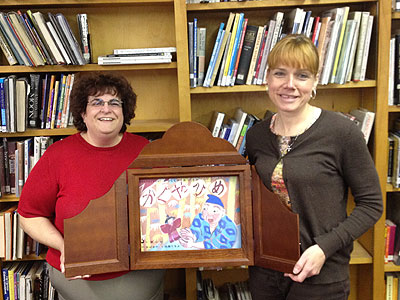
Co-Taught by: Beth Davis (left), Librarian and
Audra Rys (right), English Language Arts Chair and 9th Grade ELA teacher
Beth Davis:
I have been the Middle School/High School Librarian at Berne-Knox-Westerlo CSD for sixteen years. During that time, I have seen our collection grow and teacher/librarian collaborations have increased tremendously. In my spare time, I love to read, travel and play Mah Jongg. Listening to and watching Broadway musicals is also a frequent activity of mine. I am happily married and have an 8 year old daughter.
Audra Rys:
I have been an English Teacher at Berne-Knox-Westerlo for 21 years and English Department Chairperson for 12 years. I have loved working and collaborating with Beth Davis, our school librarian. In my free time, I enjoy running, reading, traveling and playing weekly trivia. I also enjoy spending time with my many nieces and nephews. I especially like taking them to local historical sites and museums to share my other love (besides literature): History.
How did you first hear about kamishibai?
In 2010, Mrs. Davis attended the SLMS/NYLA (School Library Media Section of the New York Library Association). One of the sessions she attended was entitled, “Discover Kamishibai – Traditional Japanese Story Cards.” This was the first time that she had ever heard of this form of storytelling.
What attracted you to kamishibai and to integrating it into your teaching or other work?
Audra Rys, the 9th grade ELA teacher and ELA chair at my school, and I have been collaborating for over ten years on a unit we call, “The 3F's: Fairy Tales, Folklore, and Fables.” Once a week, for the whole school year, each of the 9th grade classes comes to library and studies units devoted to the stories of different time periods or other parts of the world. Some of the units included in the 3F's are: Aesop, Greek and Roman Mythology, African Folktales, Chinese Folktales, and The Grimm Brothers. We had been looking for a new unit to add to the program, and Kamishibai seemed like a perfect fit.
Describe some of the ways you use kamishibai with your students.
Our Kamishibai unit takes several weeks to complete, as we only get together once per week. Here is an outline of our unit:
Week 1: Mrs. Davis explains that we will be starting a new unit on Japanese story telling. Suddenly, the Kamishibai man (played by Miss Rys—in costume) comes out from a hiding spot while the other teacher/students simulate the excitement that would have occurred when he appeared. Then the Kamishibai man explains who he is and Mrs. Davis reads the picture book Kamishibai Man by Allen Say. Miss Rys, as the Kamishibai Man, then shows the students her wooden theater and performs the Kamishibai of “Momotaro: The Peach Boy.” During the course of the period, students are treated to types of actual Japanese candy (purchased at an Asian market), which are given out by the Kamishibai Man. Students will then begin a free write about Kamishibai, which will be due the next time we meet.
Week 2: A quick review of Kamishibai occurs. Students then hear the Kamishibai of “The One Inch Boy.” The class is then divided into groups of three to four people per group. Each group is given a set of Kamishibai cards and practices reading them to each other, as they also become familiar with the way they are constructed. Once done with the first set, the groups trade stories so that each group gets to read/hear a number of stories during the period.
Week 3: Staying in their same groups, students look through books of Japanese fairy tales and folktales to find a story they want to turn into Kamishibai. After picking the story, students spend the next few weeks plotting out their cards, typing the story with directions on how lines are to be read and creating their own stages using cereal boxes. All of this usually takes about three class sessions.
Final week of Kamishibai Unit: Students perform their Kamishibai using their own stages.
During the course of the unit, students are also introduced to aspects of Japanese culture.
What do you think students are getting out of this particular format? How have they responded?
This is the second year we have taught this unit. The response from students has been very enthusiastic. They enjoy learning about a different type of storytelling and really get into the creative part of the project. The class responses to trying candy from another country is also very interesting. This is the link to a multimedia presentation that followed the first year we did this project. The video was created by Nanette Morges, our district's Communication Specialist at the time.
Nadine Grisar—Brooklyn, New York
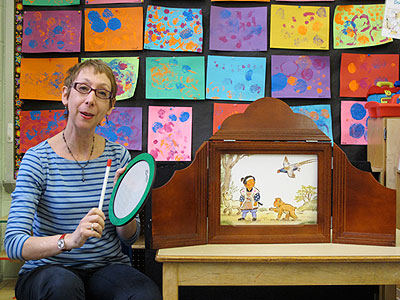
Nadine Grisar has been telling stories since 1988, specializing in interactive stories for children and families. She has performed at museums, libraries, religious institutions, schools and environmental and community centers. She has presented kamishibai stories at the Japan Society and the Kinokuniya Bookstore in New York City. Nadine is a teacher at P.S. 217 in Ditmas Park, Brooklyn. She is a member of the Brooklyn Community Storytellers.
How did you first hear about kamishibai?
As a storyteller, I had been reading and telling many traditional Japanese folktales. I became interested in Japanese culture to support my telling of these stories. I found out about Kamishibai through the Japan Society's Teacher Education Program. Margaret Eisenstadt was offering a kamishibai workshop for teachers, which I attended.
What attracted you to kamishibai and to integrating it into your teaching or other work?
I was teaching at P.S. 217 in Ditmas Park, Brooklyn. Our students come from many diverse cultures and many are English language learners. Although I mostly presented my stories orally, (without books or illustrations), I thought presenting stories using Kamishibai cards would help my students better understand the stories through their strong visual images
Describe the ways you use kamishibai with your students. (Please provide as specific examples as possible.)
I often provide cultural background and the history of Kamishibai. I use illustrations from or sometimes read the book Kamishibai Man by Alan Say.
I incorporate traditional Japanese songs with some stories, for example, Momotaro. I teach the children a rhythm pattern before I tell the story. I have them practice the pattern and invite them to tap and clap when I sing the song at different intervals during the story.
I invite the students to chant during, Hats for Jizos, when the Jizos are delivering the gifts to the old man and woman. “Yoisa, hoisa!”
I include sound effects for the animals in How The Years Got Their Names. I think it helps the children visualize the animals and their different qualities. I use a thunder tube for the dragon who is “lightning fast” and some musical spoons for the clippety-clop sound of the horse's hooves, etc.
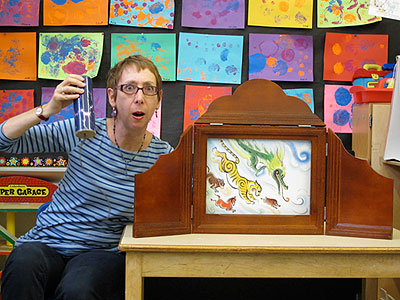
I try to find different voices for each character in a story. I read directly from the cards, which are very dialogue driven. I often think of the stories as old-time radio shows. I think the vocal variations help the children envision each character's personality and help them understand the story.
What do you think students are getting out of this particular format? How have they responded?
By providing strong visual images and soundscapes, the students become immersed in the story. When the children “join in” with rhythm and sound, it brings about as sense of community and instills energy and happiness. By participating vocally and through movement, the listeners take an active role and become part of the story.
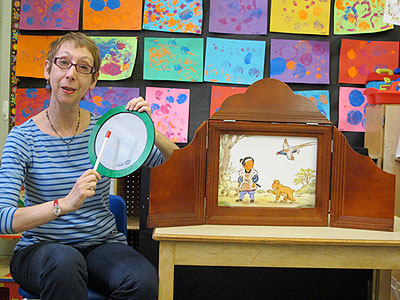
|
|






